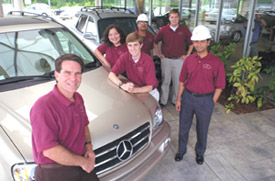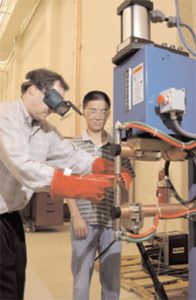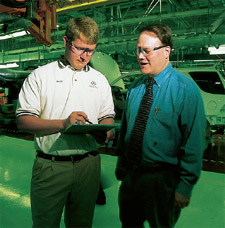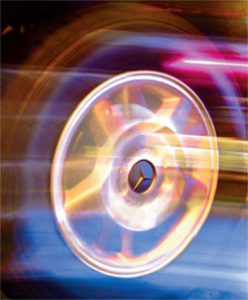The International Automobile Industry Finds a Home in Alabama
by Bill Gerdes and Janice M. Fink
“The spark that caused the automobile manufacturing fire in this state was struck at The University of Alabama,” says Dr. Malcolm Portera, chancellor of The University of Alabama System.
That fire shows no signs of diminishing. The University of Alabama, with its teaching, research and service mission, has been an integral part of the automobile manufacturing expansion into the Heart of Dixie, supplying engineering, management and manufacturing expertise, as well as an educated labor force.
During the past two decades, the nation’s automotive manufacturing industry has steadily spread southward, from the Great Lakes, across the prairies of Indiana and Illinois, through western Kentucky, over the Nashville hills, and into Alabama, where it has found fertile ground.
The Southern Automotive Corridor, as it is now called, generally follows Interstates 65 and 75. Automakers from around the world are considering expansions or new operations in the Southeast, which accounted for 23.1 percent of all U.S. vehicle production in 1998, a percentage that is climbing almost too fast to track.
The first automaker to settle in Alabama was Mercedes-Benz, in 1993. Mercedes is now adding a $600 million expansion to its Vance operation. Then came Honda in Lincoln in 2000, followed by Hyundai in Montgomery earlier this year. Sandwiched in between was the Toyota V-8 engine plant in Huntsville, and as many as 130 automotive suppliers statewide. Estimates put the capital investment statewide by the automotive industry at more than $10 billion and climbing.
The Business College Paves the Way
The automobile industry and UA have a long and colorful history. In 1983, the Rochester Products Plant, a division of General Motors, had announced it was closing its Tuscaloosa plant, eliminating 200 jobs. GM contacted Portera, then executive assistant to UA President Joab Thomas, to ask if the University could help. Portera contacted now UA interim President J. Barry Mason, then chairman of the business school’s division of management and marketing, and asked Mason to look at the situation.
“We needed to save $1.5 million,” Portera said. “Barry called me back and said, ‘We can do it.'” Mason chaired a task force that identified $1.5 million in cost savings, which was achieved in eight months, and the effort made national headlines. GM reversed its decision to close and announced instead a $14 million modernization effort that lured two additional automotive suppliers to locate in Tuscaloosa. “They created the factory of the future and a new product,” Portera said. “We realized that carburetors were a thing of the past and that fuel injection was the future.”
Another key incident occurred after GM announced plans to build a new car, the Saturn, and Portera and others began working on a model to attract the Saturn plant for Tuscaloosa County. Saturn chose Spring Hill, Tenn., but the same model was used to help recruit Mercedes-Benz.
“Had Alabama not landed Mercedes, there would be no auto assembly industry in Alabama,” Portera said.
“We were able to put the business principles into practice, and we had leadership willing to take the risk. It took folks with vision,” Portera said.
The next automaker to choose central Alabama was Honda, which now makes its Odyssey minivan in Lincoln. Portera said one of the major attractions for Honda was Mercedes and the secondary component parts system that was springing up.
All of which bring us to Hyundai. As Portera recalls, he received a telephone call one afternoon from a Korean businessman who had earned his doctorate at the University of Alabama school of business. “He asked if I could be in my office in 15 minutes to take a call. I told him I could. I was traveling back to Tuscaloosa from our Birmingham office.”
The call was from the U.S. president of Hyundai, whose Korean headquarters is located near Pusan University, which has had a close relationship with UA for more than 30 years. Some of the Hyundai leadership have earned graduate degrees from the UA business school.
UA was part of the original presentation to Hyundai and focused on the Alabama Institute for Manufacturing Excellence and the University Transportation Center for Alabama, both headquartered on the UA campus. Hyundai ultimately chose Montgomery for its first American plant.
Productivity Center Links Automobiles with Academia

A major link between the University and the automobile manufacturing industry in the state has been the Alabama Productivity Center, the impetus for which was to save the Rochester Products Plant. The APC is a nonprofit University outreach organization established in 1986 by the University and Alabama Power Co. Housed in the business school, the center coordinates applied research and technical assistance programs across the campus.
Dr. David Miller, professor of manufacturing management in the Culverhouse College of Commerce and Business Administration and director of the APC, said faculty and students have been used as problem-solving teams to address specific, challenging issues facing organizations around the state.
“The company is presented with implementable solutions, and our faculty and students are involved in invaluable education experiences and exposure,” said Miller. “In addition, we have ploughed into tuition and stipends for graduate students over $3 million, much of it from the automotive industry. It provides a very rich dimension to their education because they learn hands-on — they use the technologies they learn in class and then see the practical implications.”
According to Miller, the APC has provided solutions at several points in the evolution of the state’s automotive industry. For example, he said the productivity center helped Mercedes-Benz design its “in-bound logistics system with a focus on making sure components required by Mercedes were delivered just in time and in the proper sequence and at minimal cost.”
“ARD Logistics in Cottondale feeds parts to Mercedes-Benz. The center is helping to design a quality control system to allow the company to become certified in the newest industry quality standards,” he said.
Miller said computer modeling and simulation have been used to assist several automotive firms to address design and operating decisions, such as reducing bottleneck and sizing material handling equipment.
Engineers Assist with Production and Quality Assurance

Engineers at the University are assisting automobile makers with various research and education projects. “The College of Engineering directly assists automotive manufacturers and their suppliers through technology transfer, applied research, and Small Business Innovation Research and Small Business Technology Transfer subcontracts,” said Dr. Timothy J. Greene, assistant vice president for research and academic affairs at UA and former dean of the University’s College of Engineering. “We have positioned ourselves to participate in the automotive industry by focusing on five research areas — manufacturing, transportation, materials, information technology and environment.
“Specific topics we are addressing include internal combustion engines, spot weld design, vibrations and noise abatement, alternative fuel sources including fuel cells, composite materials, manufacturing processes and supply chain management,” said Greene.
Dr. Robert Batson, professor of industrial engineering, spent a recent sabbatical year as a guest of the Quality Engineering group at Mercedes-Benz U.S. International in Vance, where he developed a first-hand understanding of modern automotive production systems and assembly processes.
Mercedes operates a “lean manufacturing” system to accomplish assembly of its M-class at the Vance plant, whereby first-tier suppliers from the local area provide preassembled modules for the assembly line on a just-intime basis, with modules delivered in the sequence they are needed. These first-tier suppliers, in turn, rely on subsequent tiers of companies for their components. Batson assessed “how is quality assured” in this system, an aspect of supply-chain management not covered in many textbooks. “For Mercedes and suppliers alike, the goal is to develop a mistake-proof process,” he said. Batson provided statistical support to help quality engineers better understand performance data, from torque checks on bolting to quality metrics on incoming parts.
He also assisted in the start-up of a company-wide supplier improvement effort, coordinating training courses in process auditing and performance improvement. He then called on his UA colleague, Dr. Gary Moynihan, professor of industrial engineering, to develop a statistical software program, now implemented at the plant, to help manage supplier performance. Batson has incorporated his experiences at Mercedes into the statistical process control course he teaches at UA.
A research project on spot welding conducted through UA’s Center for Advanced Vehicle Technologies is also benefiting the auto industry. Dr. Mark Barkey, associate professor of aerospace engineering and mechanics, is studying durability and vibration and the fatigue performance of welded joints in a research program funded by the CAVT.
The research group, including several graduate students, is testing the durability of spot welds, which join “galvannealed” sheet metal used in the manufacture of most of today’s vehicles. Studies focus on joint characterization and the development of structural design concepts with superior durability properties, which are of significant importance for current and future generations of vehicles.
“Our goal is to help these welds maintain their strength and integrity when faced with road loads,” Barkey explained. “If spot welds in vehicles crack, obviously it causes problems. We want to find ways to make them more durable, even in extreme conditions.
“It is clear how important this is to the auto industry,” said Barkey, “when you consider there are about 4,000 spot welds on every vehicle — nearly all welded by robots on assembly lines.” Barkey’s familiarity with automobile manufacturing comes from firsthand experience — before becoming a professor, he worked as a senior engineer for General Motors.
The Electromechanical Systems Laboratory (EMSyL), headquartered on the UA campus, is studying advanced motion control and the systems that accomplish it. EMSyL is a joint project including UA, Auburn, Shelton State Community College, Kansas State University, the Alabama School of Math and Science, two national labs and several industrial partners. Sponsored in part by the National Science Foundation’s Experimental Program to Stimulate Competitive Research, its focus is research on large-scale electromechanical systems.
“We study new methods of high-power motion control as well as replacing existing methods, such as hydraulic systems, with electromechanical devices,” said Dr. Timothy Haskew, associate professor of electrical and computer engineering and director of the lab. This directly impacts the auto industry because there is a growing trend to use electromechanical systems for propulsion and for other applications in vehicles, he said.
“Electromechanical motion control systems are poised to improve the performance, reliability and efficiency of motors, and reduce the cost and maintenance requirements,” Haskew explained. Motor control efficiency is a critical aspect in new vehicle technologies, such as hybrid-electric cars (which use gasoline and battery power) and fully electric cars, said Haskew.
UA Students Become the Automotive Engineers of Tomorrow
One of the greatest advantages that automakers get from their affiliation with the University is a wealth of qualified students to fill necessary roles, helping to build their expansion and ensure their future, said Roy Gregg, director of UA’s Cooperative Education (Co-op) Program.
The Co-op program serves students University-wide by placing them in jobs where they receive employment experience by working every other semester while studying at UA. At any given time there are about 400 Co-op students gaining work experience in their fields. Many continue with the companies as permanent employees.
According to Michelle Galipeau, employment specialist for Mercedes-Benz U.S. International in Vance, that company’s involvement with Co-op is a definite win-win relationship. “Not only are students gaining valuable work experience, but MBUSI is investing in our future workforce as well,” she said.
“At the moment, we are the only University in the country that can place Co-op students with Mercedes,” Gregg emphasized. Because Mercedes tends to hire only seasoned professionals, and normally doesn’t offer internships, “through our Co-op relationship, UA has become the predominate gateway into Mercedes for someone coming straight out of college,” he said. Two years ago, Mercedes-Benz established a $1 million endowment at the University for student-centered initiatives, and 40 percent of this was earmarked for the expansion and enhancement of the Co-op program relationship.
Other vehicle-related companies that regularly hire UA engineering graduates include Honda, Mitsubishi, General Motors, Harley-Davidson, Globe Motors, Delphi Automotive Systems, Rockwell Automation, Carlisle Engineered Products and Ogihara.
“Our students are very important to automakers moving into the area,” said Angelia Knight-Adams, director of Engineering Career Services in the College of Engineering. “Before Honda broke ground for their plant near Lincoln they set up a meeting with the University to talk about recruiting.”
A Bright Road Together

As important as the economic, technological, applied research, human resource and educational aspects of the relationship between the University and the automotive industry, are the social benefits brought about by the state’s emergence as a major player in the automotive game, points out UA interim President J. Barry Mason.
“That has always been the draw,” Mason said. “The benefits to UA are multifaceted. Once jobs are created, there is an immediate increase in the tax base, which means better roads, better schools, better health care, a better social climate for everyone. The quality of education for students goes up, without cost to UA.
“It helps bring a higher quality of faculty who see the chance to interact with worldclass companies.
“Because of these major facilities, we have a broader, more diverse leadership and population in our communities, and we re-define the image of our state. Their need for skilled workers focuses more attention on education. All of this brings more hope to many communities through increased economic opportunity.
“There is not a company in the world now that can afford to NOT look at Alabama.”
So what is next?
“I think Alabama should fully develop its auto industry,” Portera said. “First, we need to develop a component parts industry.” Secondly, he said, Alabama needs to persuade the auto manufacturers in the state to add new models. “Third,” said Portera, “the state needs to expand its commitment to both information technology and biomedical technology.
“I want it to be possible for my children to stay in Alabama because there is opportunity here.”
